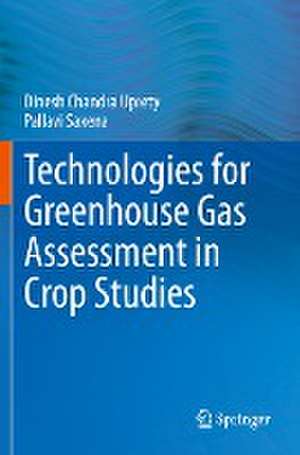Technologies for Green House Gas Assessment in Crop Studies
Autor Dinesh Chandra Uprety, Pallavi Saxenaen Limba Engleză Paperback – 2 apr 2022
| Toate formatele și edițiile | Preț | Express |
|---|---|---|
| Paperback (1) | 587.99 lei 38-45 zile | |
| Springer Nature Singapore – 2 apr 2022 | 587.99 lei 38-45 zile | |
| Hardback (1) | 944.19 lei 3-5 săpt. | |
| Springer Nature Singapore – 2 apr 2021 | 944.19 lei 3-5 săpt. |
Preț: 587.99 lei
Preț vechi: 763.62 lei
-23% Nou
Puncte Express: 882
Preț estimativ în valută:
112.51€ • 117.89$ • 93.01£
112.51€ • 117.89$ • 93.01£
Carte tipărită la comandă
Livrare economică 07-14 aprilie
Preluare comenzi: 021 569.72.76
Specificații
ISBN-13: 9789811602061
ISBN-10: 9811602069
Pagini: 134
Ilustrații: XVII, 134 p. 19 illus., 7 illus. in color.
Dimensiuni: 155 x 235 mm
Ediția:1st ed. 2021
Editura: Springer Nature Singapore
Colecția Springer
Locul publicării:Singapore, Singapore
ISBN-10: 9811602069
Pagini: 134
Ilustrații: XVII, 134 p. 19 illus., 7 illus. in color.
Dimensiuni: 155 x 235 mm
Ediția:1st ed. 2021
Editura: Springer Nature Singapore
Colecția Springer
Locul publicării:Singapore, Singapore
Cuprins
Chapter 1: Introduction.- Chapter 2: Carbon dioxide.- Chapter 3: Methane.- Chapter 4: Nitrous Oxide.- Chapter 5: Ozone.- Chapter 6: Temperature.- Chapter 7: The Plant Water Status.- Chapter 8: Summary.
Notă biografică
Dr.Dinesh Chandra Uprety is an Emeritus Scientist at the Indian Agricultural Research Institute, New Delhi and has 43 years research and teaching experience. He has led the South Asian and Indian program on CO2 enrichment research and technology. He has designed and developed Open Top Chamber (OTC), FACE and FATE climate change research technologies for the South Asian region, bringing India in to GCTE research network. He was a member of the IPCC working group II. He has published about 150 research papers, 4 books and 5 chapters in edited books relating to climate change and agriculture. He is Fellow of the National Academy of Sciences (FNASc); Fellow, START International, USA; Indian Soc. Plant Physiology (FISPP); and received the Gold medal of Acad. Advanc. Agric.Sci.India (AAAS); Sukumar Basu Award in 2004; Eminent Citizen MNERGA 2010; B.N.Singh Memorial Award BHU Centenary Award 2016 and Life Time Achievement Award 2020, by the Society for science of climate change and sustainable environment, New Delhi.
Dr. Pallavi Saxena is an Assistant Professor, Environmental Science, Hindu College, University of Delhi, Delhi, India. She has been awarded DST Fast Track Young Scientist Award at SES, Jawaharlal Nehru University, New Delhi, India. She has completed her Post Doc from SPASC, Physical Research Laboratory (PRL), Ahmedabad, India. She has awarded Doctor of Philosophy in Environmental Studies from University of Delhi on “Effect of Photochemical Pollutants on Plant Species”. Her area of interest is air pollution and plant physiology. She is elected as Chair of South Asia and Middleeast Region of ECR, iLEAPS, UK. She is also a co-author and collaborator from India in TOAR from 2015 onwards.
Textul de pe ultima copertă
Global climate change is one of the most serious threats to the environment of the earth and to the crop production. Crop’s vulnerability to climate change stress caused by the greenhouse gases emission is a serious concern. This book describes various technologies and methods including the simulation of the future climate changes, studying the response of crop plants and characterizing their responses physiologically and biochemically. It includes the latest information of protocols and technologies for climate change research on agriculture. This book is of interest to teachers, researchers, climate change scientists, capacity builders and policymakers. Also the book serves as additional reading material for undergraduate and graduate students of agriculture, forestry, ecology, soil science, and environmental sciences. National and international agricultural scientists, policy makers will also find this to be a useful read.
Caracteristici
Covers technologies and methods including the simulation of the future climate changes. Elucidates the response of crop plants to GHGs and characterizes their responses. Includes the latest information on technologies for climate change research on agriculture. Useful literature in decision making to target policies aimed at amplifying agricultural productivity.
